10 Other Types of Equations
Topics Covered:
Solving Polynomial Equations by Factoring
We have already solved polynomial equations of degree one. Polynomial equations of degree one are linear equations and are of the form ax + b = c.
We have now also solved polynomial equations of degree two. A polynomial equation of degree two is called a quadratic equation.
But what about those equations with a degree of 3 or higher? Some of them we will be able to solve by Factoring.
Try it! – Solve a Polynomial by Grouping
Solve by grouping: x3 + x2 − 9x − 9 = 0.
Solution:
This polynomial consists of 4 terms, which we can solve by grouping. Grouping procedures require factoring the first two terms and then factoring the last two terms. If the factors in the parentheses are identical, we can continue the process and solve, unless more factoring is suggested.
| Algebraic |
| x3 + x2 − 9x − 9 = 0 |
| x2(x + 1) − 9(x + 1) = 0 |
| (x2 − 9)(x + 1) = 0 |
The grouping process ends here, as we can factor x2 − 9 using the difference of squares formula.
| Algebraic |
| (x2 − 9)(x + 1) = 0 |
| (x − 3)(x + 3)(x + 1) = 0 |
| x = 3 |
| x = −3 |
| x = −1 |
The solutions are 3,−3, and −1. Note that the highest exponent is 3 and we obtained 3 solutions.
We looked at solving quadratic equations by factoring when the leading coefficient is 1. When the leading coefficient is not 1, we solved by grouping. Grouping requires four terms, which we obtained by splitting the linear term of quadratic equations. We can also use grouping for some polynomials of degree higher than 2, as we saw here, since there were already four terms.
Solve Equations in the Quadratic Form
Sometimes when we factored trinomials, the trinomial did not appear to be in the ax2 + bx + c form. So we factored by substitution allowing us to make it fit the ax2 + bx + c form. We used the standard u for the substitution.
To factor the expression x4 − 4x2 − 5, we noticed the variable part of the middle term is x2 and its square, x4, is the variable part of the first term. (We know (x2)2 = x4.) So we let u = x2 and factored.
| Steps | Algebraic |
| Equation | |
| Let u = x2 and substitute. | |
| Simplify | |
| Factor the trinomial. | |
| Replace u with x2. |
If the exponent on the middle term is one-half of the exponent on the leading term, we have an equation in quadratic form, which we can solve as if it were a quadratic. We substitute a variable for the middle term to solve equations in quadratic form.
How to solve an equation in quadratic form.
- Identify the exponent on the leading term and determine whether it is double the exponent on the middle term.
- If it is, substitute a variable, such as u, for the variable portion of the middle term.
- Rewrite the equation so that it takes on the standard form of a quadratic.
- Solve using one of the usual methods for solving a quadratic.
- Replace the substitution variable with the original term.
- Solve the remaining equation.
Similarly, sometimes an equation is not in the ax2 + bx + c = 0 form but looks much like a quadratic equation. Then, we can often make a thoughtful substitution that will allow us to make it fit the ax2 + bx + c = 0 form. If we can make it fit the form, we can then use all of our methods to solve quadratic equations.
Notice that in the quadratic equation ax2 + bx + c = 0, the middle term has a variable, x, and its square, x2, is the variable part of the first term. Look for this relationship as you try to find a substitution.
The next example shows the steps for solving an equation in quadratic form.
Try it! – How to Solve Equations in Quadratic Form
Solve: 6x4 − 7x2 + 2 = 0
Solution:




In the next example, the binomial in the middle term, (x − 2) is squared in the first term. If we let u = x − 2 and substitute, our trinomial will be in ax2 + bx + c form.
Try it!
Solve: (x − 2)2 + 7(x − 2) + 12 = 0.
Solution:
| Steps | Algebraic |
| Equation | |
| Prepare for the substitution. | |
| Let u = x − 2 and substitute. | |
| Solve by factoring. | |
| Replace u with x − 2. | |
| Solve for x. | |
| Check: |
 |
In the next example, we notice that (![]() )2 = x. Also, remember that when we square both sides of an equation, we may introduce extraneous roots. Be sure to check your answers!
)2 = x. Also, remember that when we square both sides of an equation, we may introduce extraneous roots. Be sure to check your answers!
Try it!
Solve: ![]() .
.
Solution:
The ![]() in the middle term, is squared in the first term
in the middle term, is squared in the first term ![]() . If we let
. If we let ![]() and substitute, our trinomial will be in ax2 + bx + c = 0 form.
and substitute, our trinomial will be in ax2 + bx + c = 0 form.
| Steps | Algebraic |
| Equation | |
| Rewrite the trinomial to prepare for the substitution. | |
| Let |
|
| Solve by factoring. | |
| Replace u with |
|
| Solve for x, by squaring both sides. | |
| Check: |
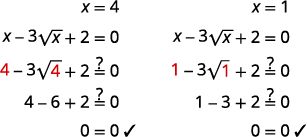 |
Substitutions for rational exponents can also help us solve an equation in quadratic form. Think of the properties of exponents as you begin the next example.
Try it!
- Solve:
 .
.
Solution:
The ![]() in the middle term is squared in the first term
in the middle term is squared in the first term ![]() . If we let
. If we let ![]() and substitute, our trinomial will be in ax2 + bx + c = 0 form.
and substitute, our trinomial will be in ax2 + bx + c = 0 form.
| Steps | Algebraic |
| Equation | |
| Rewrite the trinomial to prepare for the substitution. | |
| Let u = |
|
| Solve by factoring. | |
| Replace u with |
|
| Solve for x by cubing both sides. | |
| Check: |
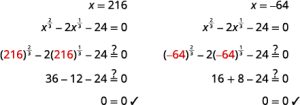 |
2. Solve: ![]() .
.
Solution:
![]() ,
, ![]()
In the next example, we need to keep in mind the definition of a negative exponent as well as the properties of exponents.
If n is an integer and a ≠ 0, then ![]() or
or ![]() .
.
Try it!
Solve: ![]() .
.
Solution:
The ![]() in the middle term is squared in the first term
in the middle term is squared in the first term ![]() . If we let
. If we let ![]() and substitute, our trinomial will be in ax2 + bx + c = 0 form.
and substitute, our trinomial will be in ax2 + bx + c = 0 form.
| Steps | Algebraic |
| Equation | |
| Rewrite the trinomial to prepare for the substitution. | |
| Let |
|
| Solve by factoring. | |
| Replace u with |
|
| Solve for x by taking the reciprocal since |
|
| Check: |
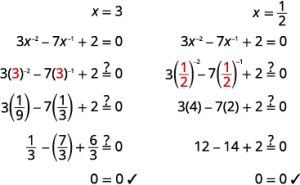 |
Access this online resource for additional instruction and practice with solving quadratic equations.
Absolute Value Equations
As we prepare to solve absolute value equations, we review our definition of absolute value.
Absolute Value
The absolute value of a number is its distance from zero on the number line.
The absolute value of a number n is written as |n| and |n| ≥ 0 for all numbers.
Absolute values are always greater than or equal to zero.
We learned that both a number and its opposite are the same distance from zero on the number line. Since they have the same distance from zero, they have the same absolute value. For example:
−5 is 5 units away from 0, so |−5| = 5.
5 is 5 units away from 0, so |5| = 5.
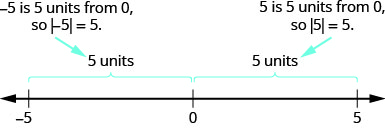
For the equation |x| = 5, we are looking for all numbers that make this a true statement. We are looking for the numbers whose distance from zero is 5. We just saw that both 5 and -5 are five units from zero on the number line. They are the solutions to the equation.
If |x| = 5
then x = −5 or x = 5.
The solution can be simplified to a single statement by writing x = ±5. This is read, “x is equal to positive or negative 5”.
We can generalize this to the following property for absolute value equations.
For any algebraic expression, u, and any positive real number, a,
if |u| = a
then u = −a or u = a
Remember that an absolute value cannot be a negative number.
Try it!
Solve: ⓐ |x| = 8 ⓑ |y| = −6 ⓒ |z| = 0
Solution:
ⓐ
| Steps | Algebraic |
| Equation | |x| = 8 |
| Write the equivalent equations. | x = −8 or x = 8 |
| x = ±8 |
ⓑ
| Steps | Algebraic |
| Equation | |y| = −6 |
| No solution | |
| Since an absolute value is always positive, there are no solutions to this equation. |
|
ⓒ
| Steps | Algebraic |
| Equation | |z| = 0 |
| Write the equivalent equations. | z = −0 or z = 0 |
| Since −0 = 0, | z = 0 |
| Both equations tell us that z = 0 and so there is only one solution. | |
To solve an absolute value equation, we first isolate the absolute value expression using the same procedures we used to solve linear equations. Once we isolate the absolute value expression we rewrite it as the two equivalent equations.
- Isolate the absolute value expression.
- Write the equivalent equations.
- Solve each equation.
- Check each solution.
Try it! – How to Solve Absolute Value Equations
- Solve: |5x − 4| − 3 = 8.
Solution:



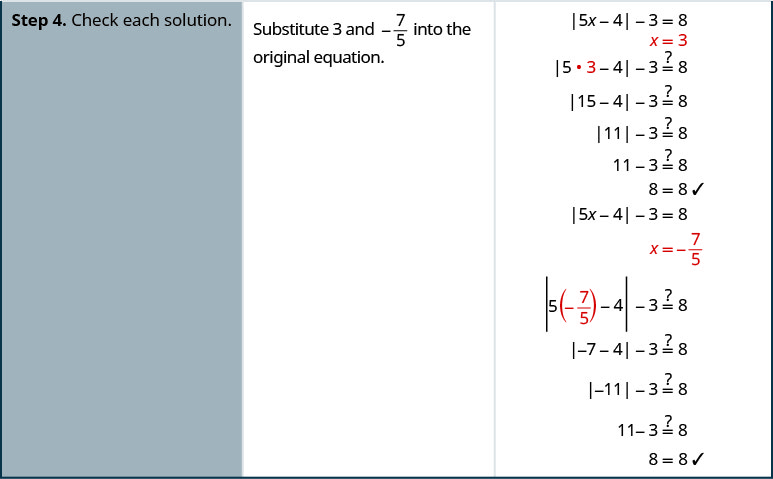
2. Solve: 2|x − 7| + 5 = 9.
Solution:
| Steps | Algebraic |
| Equation | 2|x − 7| + 5 = 9 |
| Isolate the absolute value expression. | 2|x − 7| = 4 |
| Simplify | |x − 7| = 2 |
| Write the equivalent equations. | x − 7 = −2 or x − 7 = 2 |
| Solve each equation. | x = 5 or x = 9 |
| Check: | 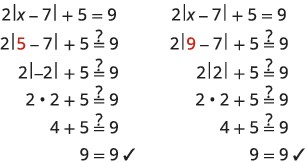 |
3. Solve: ![]() .
.
Solution:
No solution
Key Concepts
- Binomial Squares
(a + b)2 = a2 + 2ab + b2(a − b)2 = a2 − 2ab + b2 - Absolute Value Equations
For any algebraic expression, u, and any positive real number, a,
if |u| = a
then u = −a or u = a
Remember that an absolute value cannot be a negative number.
- How to Solve Absolute Value Equations
- Isolate the absolute value expression.
- Write the equivalent equations.
- Solve each equation.
- Check each solution.

